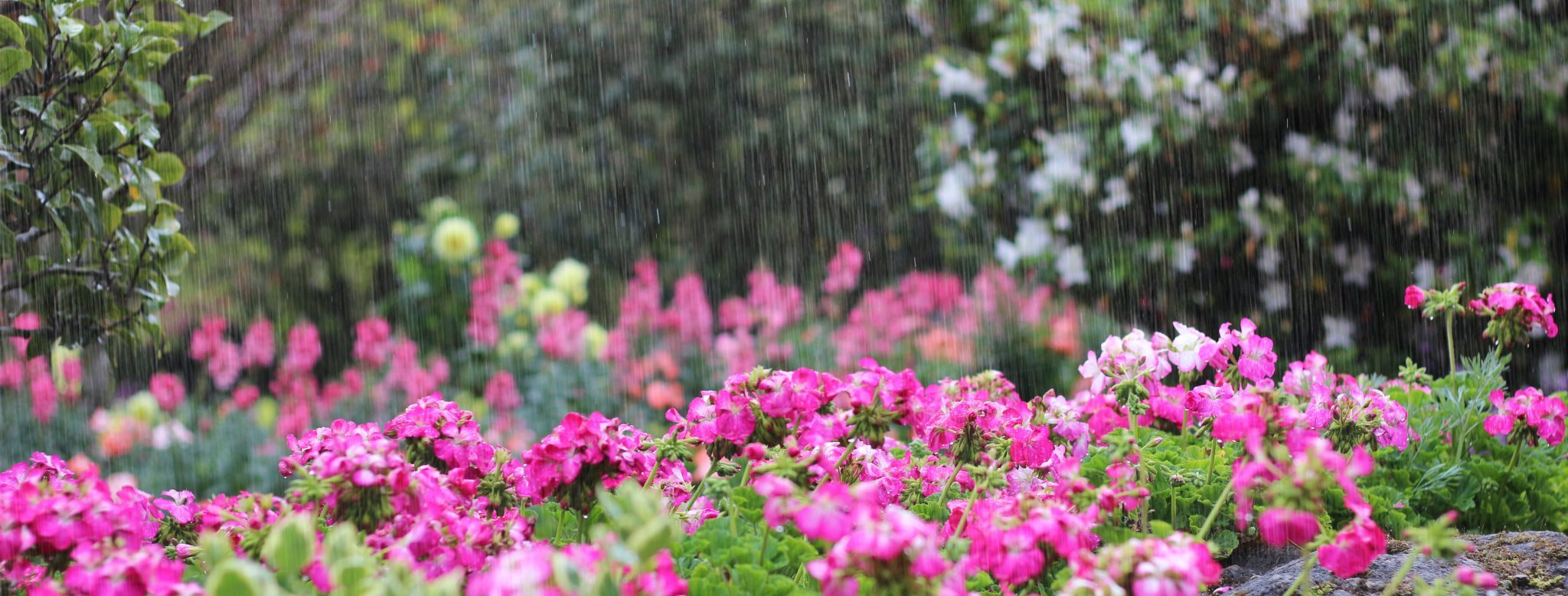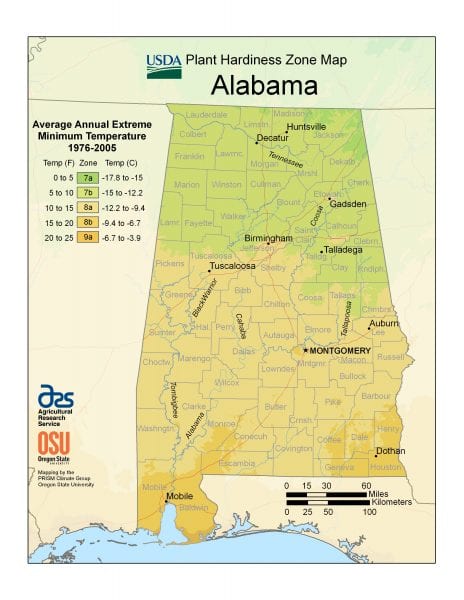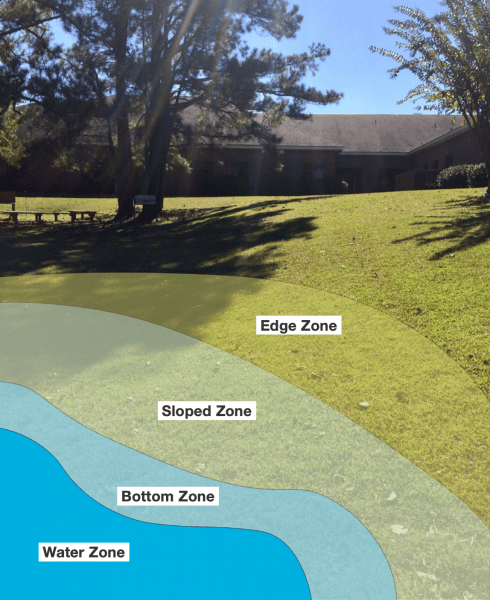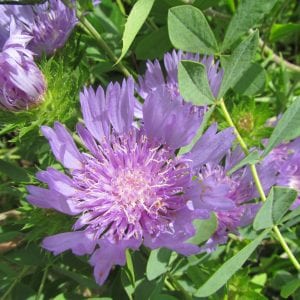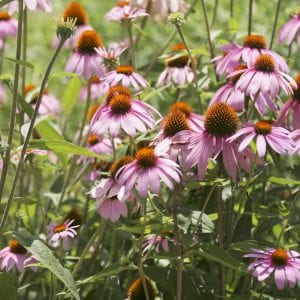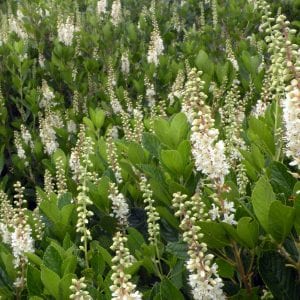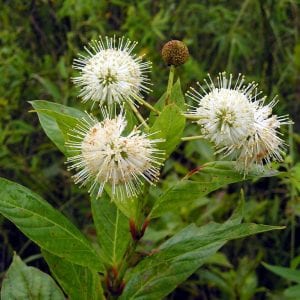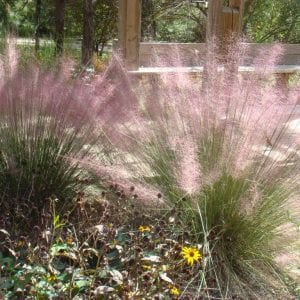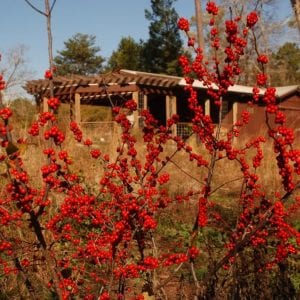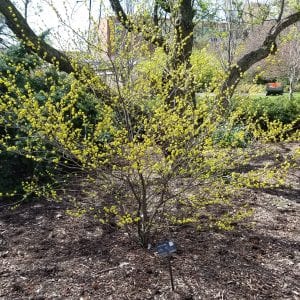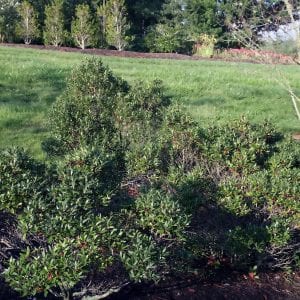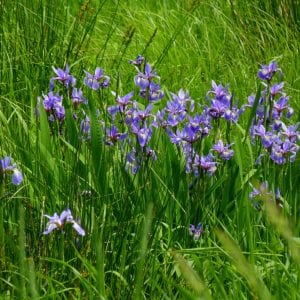Fish & Water

Plants play an important role in rain garden function:
- Provide wildlife habitat and seasonal aesthetic appeal § Take up nutrients and some heavy metals present in stormwater runoff
- Stabilize soil and enhance infiltration rates
Know Your Plant Hardiness Zone
- When selecting plants, be aware of your area’s hardiness zone so you know what temperatures your garden will need to tolerate as well as what time of year is best for planting. Alabama is located in Zones 7b to 8b in the Southeast region of the map.
- Figure 29. USDA Alabama plant hardiness zones
- Figure 30. Plant rain gardens according to wetness zones.
Planting by Wetness Zones
Plants used in rain gardens must be able to tolerate both wet and dry conditions. Plants more suited for wet conditions should be placed in the center of the rain garden, or wherever the garden holds water the longest. Plants that prefer drier conditions should be placed on the slope of the rain garden.
Water zone. This is the deepest part of the rain garden and will stay wet the longest, while the edges will be drier. Plants that are suited for substantial runoff for long periods belong here.
Bottom zone. This area experiences frequent pooling and is the coolest area of the garden (cool night air tends to circulate in this low spot). This zone supports plant species that can tolerate frequent pooling water.
Sloped zone. These are the sloped sides of the rain garden. This zone is intermittently wet from runoff but does not collect water for a long time. Plants here should be suited to occasional saturation and be resistant to drought.
Edge zone. This includes the outer edges and surrounding area. Wetness depends on site conditions. This is the driest and warmest area of the garden. It is beneficial to plant ground cover to prevent erosion.
In your rain garden, avoid planting trees (they typically take up root space and can shade out other plants), plants with aggressive root systems, and plants that cannot tolerate having “wet feet” (they are susceptible to root rot).
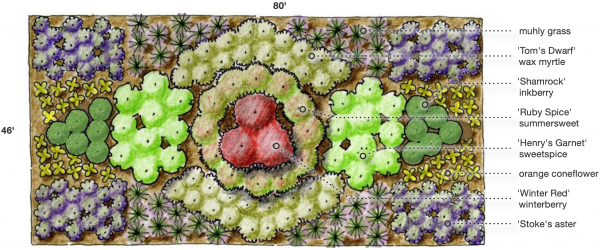
Figure 31. Example of a symmetrical planting plan; best for locations seen from above or an aerial view.
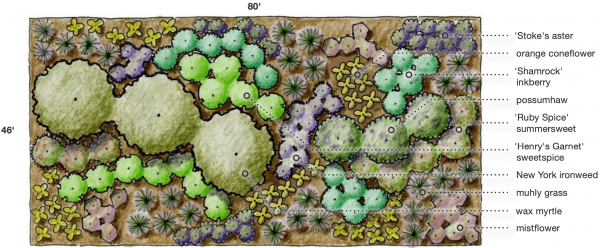
Figure 32. Example of a more natural planting plan, with plants grouped for color and arranged by height so that most plants and their colors are visible.
Creating a Planting Plan
Creating a rain garden planting design makes installation much easier by helping you determine how many plants to buy and where to place specific plants.
When creating a plan, consider the following details:
- Water tolerance. Which plants will grow best in different zones of the rain garden?
- Aesthetics. Consider how your rain garden will look from different views. By using plants in scale with the garden size, you can place taller plants in the middle of the garden and help maintain well- defined edges by using attractive plant groupings and sedges or stones around the outside of the garden.
- Plant growth. Plan to plant according to how large the plants will be at full maturity. They may look small and widely spaced when you first plant, but they will need room to grow into full maturity.
- Seasonal interest. Include plants that bloom at various times of the year. Consider including species that are evergreen or have showy fall color.
For information on suggested plants to use in your rain garden, see table 3.
Table 3. Rain Garden Plants
* Attracts butterflies, hummingbirds, or both
- Prefers dry conditions and can tolerate drought; to be used on buffer, slope, or berm of a standard rain garden and wet rain gardens with zoned topography.
- Prefers moderate or moist conditions and can tolerate occasional inundation. Plants labeled 2 are appropriate for the center of standard rain garden designs or wet rain gardens with zoned typography.
- Prefers wet conditions and are appropriate for wet rain gardens and deep pools of wet rain gardens zoned typography.
Sun: At least 6 hours of full sun per day
Part Shade: 3 to 5 hours without direct sunlight per day.
Shade: 0 less than 2 hours of direct sunlight per day.
| Botanical Name | Common Name | Type | Soil Comments | Prefers |
|---|---|---|---|---|
| Acorus calamus | sweetflag | herbaceous grass | acidic, wet | sun to part shade (2, 3) |
| Asceplias incarnata* | swamp milkweed | herbaceous perennial | any | sun or part shade (3) |
| Amsonia tabernaemontana | Eastern bluestar | herbaceous perennial | sandy | part shade (3) |
| Baptisia alba | white wild indigo | herbaceous perennial | sandy to rocky, tolerates clay | sun (1, 2) |
| Carex crinita | fringed sedge | grasslike | any | part shade to shade (2, 3) |
| Carex comosa | bottlebrush sedge | grasslike | any | part shade (3) |
| Carex lurida | lurid sedge | grasslike | any | part shade (3) |
| Carex tribuloides | bristlebract sedge | grasslike | any | part shade (2, 3) |
| Chasmanthium latifolium | river oats | herbaceous perennial | any | part shade (2) |
| Conoclinium coelestinum* | blue mistflower | herbaceous perennial | any | sun to part shade (2) |
| Clethra alnifolia* | summersweet | shrub | any | sun or part shade (2, 3) |
| Coreopsis auriculata* | lobed tickseed | herbaceous perennial | rich, acidic | part shade (2) |
| Coreopsis lanceolata* | tickseed | herbaceous perennial | any | sun (1, 2) |
| Coreopsis nudata | Georgia tickseed | herbaceous perennial | rich, acidic | part shade (2, 3) |
| Echinacea purpurea* | coneflower | herbaceous perennial | sandy | sun to part shade (1, 2) |
| Eupatoriadelphus fistulosus* | Joe Pye weed | herbaceous perennial | acidic, moist, or wet | sun (2, 3) |
| Helianthus angustifolius | swamp sunflower | herbaceous perennial | any | sun to part shade (2, 3) |
| Helianthus angustifolius | scarlet rose mallow | herbaceous perennial | any, wet | sun (3) |
| Hibiscus moscheutos* | crimson eye rose mallow | herbaceous perennial | moist, alkaline | sun to part shade (2, 3) |
| Ilex glabra | inkberry | shrub | sandy, acidic, peaty | sun or part shade (1, 2) |
| Ilex verticillata* | winterberry | small tree | any, acidic | sun or part shade (1, 2) |
| Itea virginica | sweetspire | shrub | any, acidic | sun or part shade (1, 2, 3) |
| Juncus effusus | common rush | grasslike | any wet | sun or part shade (2, 3) |
| Lobelia cardinalis* | cardinal flower | herbaceous perennial | any, will tolerate limestone based soils | sun to part shade (2, 3) |
| Muhlenbergia capillaris | muhly grass | herbaceous grass | sandy or sandy loam | sun or part shade (2, 3) |
| Phlox carolina* | Carolina phlox | herbaceous perennial | sandy, loam, acid, will tolerate some lime | sun to part shade (2) |
| Phlox divaricata* | blue woodland phlox | herbaceous perennial | any | part shade (2) |
| Physostegia virginiana* | obedient plant | herbaceous perennial | humus-rich soils | sun to shade (1, 2, 3) |
| Pontederia cordata | pickerelweed | herbaceous perennial | any | sun to part shade (3) |
| Rudbeckia fulgida | orange coneflower | herbaceous perennial | sandy | sun or part shade (1, 2) |
| Sisyrinchium angustifolium | blue-eyed grass | grass | poor to average moist soils | sun to part shade (2, 3) |
| Stokesia laevis* | Stoke's aster | herbaceous perennial | well-drained acid sand preferred | sun or part shade (1, 2) |
| Vernonia noveboracensis* | Ironweed | herbaceous perennial | tolerates clay and acidic soils | sun (1, 2) |
| Viburnum nudum | possomhaw | shrub | prefers acid mucky soils but is adaptable | adaptable (1, 2, 3) |
General Planting Guide
- Measure distance from the center of plants.
- Space 1 foot apart for perennials.
- Space 2 to 3 feet apart for most grasses.
- Space 3 to 5 feet apart for most small to medium shrubs.
- Space 6 to 8 feet apart for larger shrubs.
- Space trees based on their mature size.Note: read plant label for spacing.
- Figure 33. Stokes’ aster (Stokesia laevis); native, herbaceous perennial evergreen with bright purple flowers, 1 to 2 feet tall. (Photo credit: “Stokes’ aster NC Botantical Garden Chapel Hill 3361” by bobistraveling licensed under CC BY 2.0)
- Figure 34. Purple coneflower (Echinacea purpurea); herbaceous perennial, 3 to 4 feet tall with pink-purple flowers that mature in early summer through mid-fall; pollinator attractor
- Figure 35. Sweet pepperbush (Clethra alnifolia); native, 4 to 6 feet tall and wide; cultivars: ‘Hummingbird’, ‘Sixteen Candles’ dwarf white 3 × 6 feet, or ‘Ruby Spice’ upright pink 8 × 5 feet; very fragrant. (Photo credit: “Clethra alnifolia (coastal sweet pepperbush), Charlestown, RI” by Doug McGrady licensed under CC BY 2.0)
Determining How Many Plants You Need
Creating a landscape drawing is best, but an equation can also be used to calculate plant quantity based on the selected spacing pattern.
quantity = area (ft.2) ÷ square feet needed per plant
Example: for a 100-square-foot rain garden planted with herbaceous perennials on 2-foot spacing in a rectangular spacing pattern, how many plants would be needed?
Spacing Equation
ft.2/plant = (X)(X) = X2
ft.2/plant = (2)(2) = 4
Quantity = 100 ft.2 ÷ 4 ft.2/plant = 25 plants
Triangular Spacing Equation
ft.2/plant = YX = [X × 0.866(X)]
ft.2/plant = [2 × 0.866(2)] = 3.4
Quantity = 100 ft.2 ÷ 3.4 ft.2/plant = 29 plants
- Figure 36. Buttonbush (Cephalanthus occidentalis); native, 6 × 6 feet, standard wetland; cut back to 1 foot each year in March or it will grow to be 12 feet; white flowers in summer, late to leaf in spring. (Photo credit: Gabriel Hurley licensed under CC BY-SA 3.0)
- Figure 37. Muhly grass (Muhlenbergia capillaris); common native favorite in rain garden designs; 4 feet tall in bloom, 3 × 3 foot mound; dry to average; semievergreen, best if cut back in winter.
- Figure 38. Winterberry holly (Ilex verticillata); gives rain gardens a pop of color in the winter; native, standard and wetland, 6 to 8 feet tall and wide; compact cultivars: ‘Berry Poppins’, ‘Red Sprite’; must plant a male pollinator (‘Mr. Poppins’, ‘Jim Dandy’)
Avoid Planting Invasive Species
Invasive species are plants that are alien to the ecosystem and whose introduction is likely to cause environmental harm without providing an equal or greater benefit. Plants that are native to your region are the best options for sustaining your naturally occurring ecosystem. Sometimes invasive plants are sold at big box stores, so do your homework before you buy.
Harm Inflicted by Invasive Species
- Inhibit the growth of surrounding plants
- Are unable to support native wildlife at critical life stages
- Use excessive resources
- Clog waterways
- Decrease soil stability
Signs of an Invasive Species
- High rate of reproduction
- High dispersal rate
- Thrive on disturbed soil
- Aggressive root systems
- Produce growth-inhibiting chemicals
- Figure 39. Spicebush (Lindera benzoin); native, 4 to 6 feet tall and wide; small yellow flowers in early spring, red berries in fall on female plants; standard wetland. (Photo credit: Dan Keck)
- Figure 40. Inkberry (Ilex glabra); native, 4 to 5 feet × 3 to 4 feet evergreen bush; quick draining; ‘Shamrock’ cultivar is small and nice for borders. (Photo credit: David Stang licensed under CC BY-SA 4.0)
- Figure 41. Blue flag iris (Iris virginica); native, 2 to 3 feet tall; standard or wetland. Note: Do not plant yellow flag iris; it’s not a native plant and is potentially invasive. (Photo credit: Rusty Clark licensed under CC BY 2.0)
Mulching
Mulch is a protective layer of a material that is spread on top of the soil. Mulches can be either organic (such as straw, bark chips, and similar materials) or inorganic (such as stones or brick chips). Organic mulches are much preferred, as they break down to return nutrients to the soil.
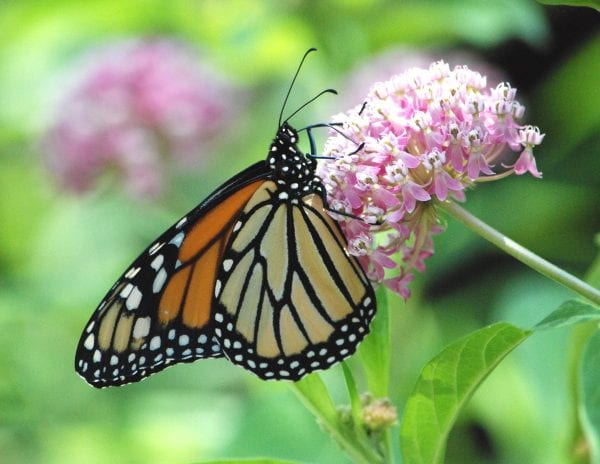
Figure 42. Swamp milkweed (Asclepias incarnata); native, 3 to 4 feet tall and wide; flowers in spring and early summer with pink or white flowers; full sun to partial shade, standard and wetland; attracts many pollinators. (Photo credit: U S Forestry and Wildlife Service Midwest Region)
Benefits of Mulch
- Protects the soil from erosion and reduces compaction from the impact of heavy rains
- Conserves moisture, reducing the need for frequent watering
- Maintains a more even soil temperature
- Prevents weed growth and provides a finished look to the garden
Alabama Invasive Species to Avoid Planting
- nandina domestica (sacred bamboo)
- autumn olive
- bamboo
- English ivy
- Chinese privet
- cogon grass
- Japanese climbing fern
- Japanese privet
- kudzu
- silk tree mimosa
- tallow tree
- tropical soda apple
- wisteria
Mulch Materials and Application
General Guidelines
- Avoid using small-sized mulches because they tend to float away. Cypress mulch is not recommended as it is harvested from cypress wetlands and not sustainable.
- Use mulch that is aged at least 6 months so that it does not rob nitrogen from establishing plants.
- Remember that application time depends on what you hope to achieve by mulching. A mulched soil in the summer will be cooler than an adjacent unmulched soil; in the winter, the mulched soil may not freeze as deeply.
- When applying mulch, leave an inch of space around the plants to help prevent diseases that flourish in excessive humidity.
- Remove weeds before spreading mulch.
Watering a Rain Garden
Water the garden during initial planting and extended dry periods. Otherwise, the water from frequent rainfall should be sufficient to maintain plant life.
 This is an excerpt from How to Install a Rain Garden, ANR-2768.
This is an excerpt from How to Install a Rain Garden, ANR-2768.
Laura Bell, Project Coordinator; Eve Brantley, Water Resources Specialist and Professor; Caitlin Sweeney, Assistant Coordinator; and Naomi Pitts, Assistant Coordinator, all with Alabama Extension Water Program at Auburn University

